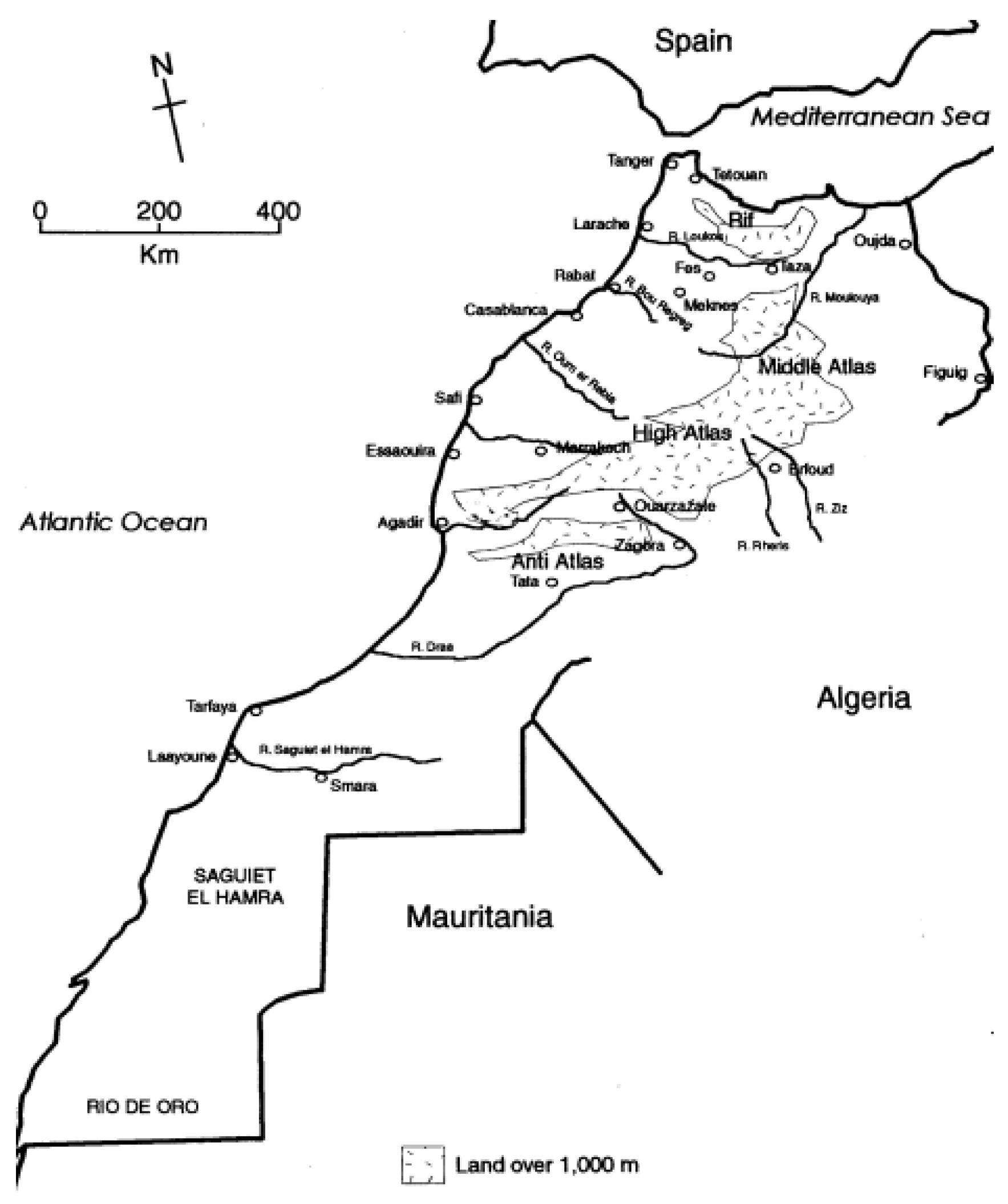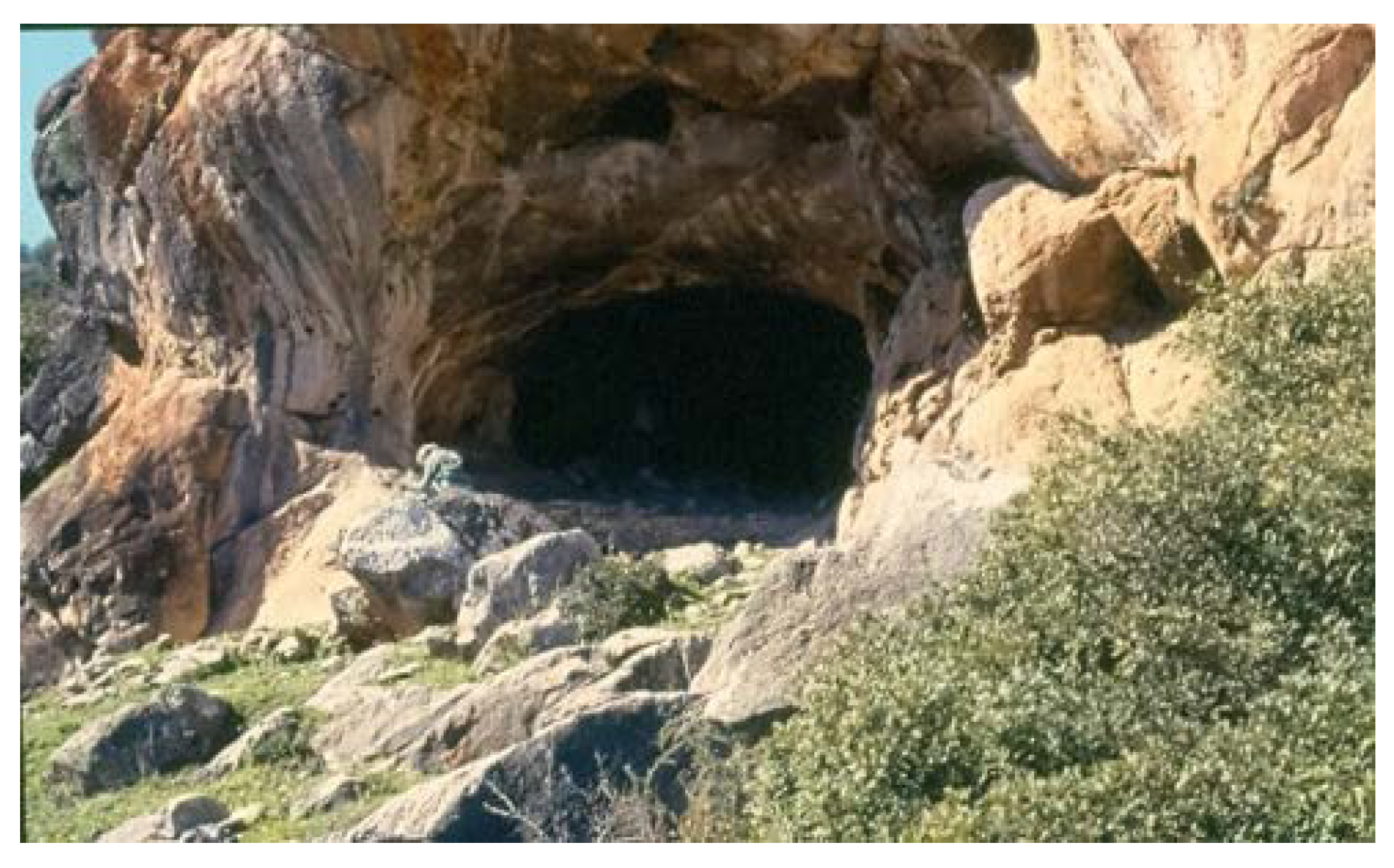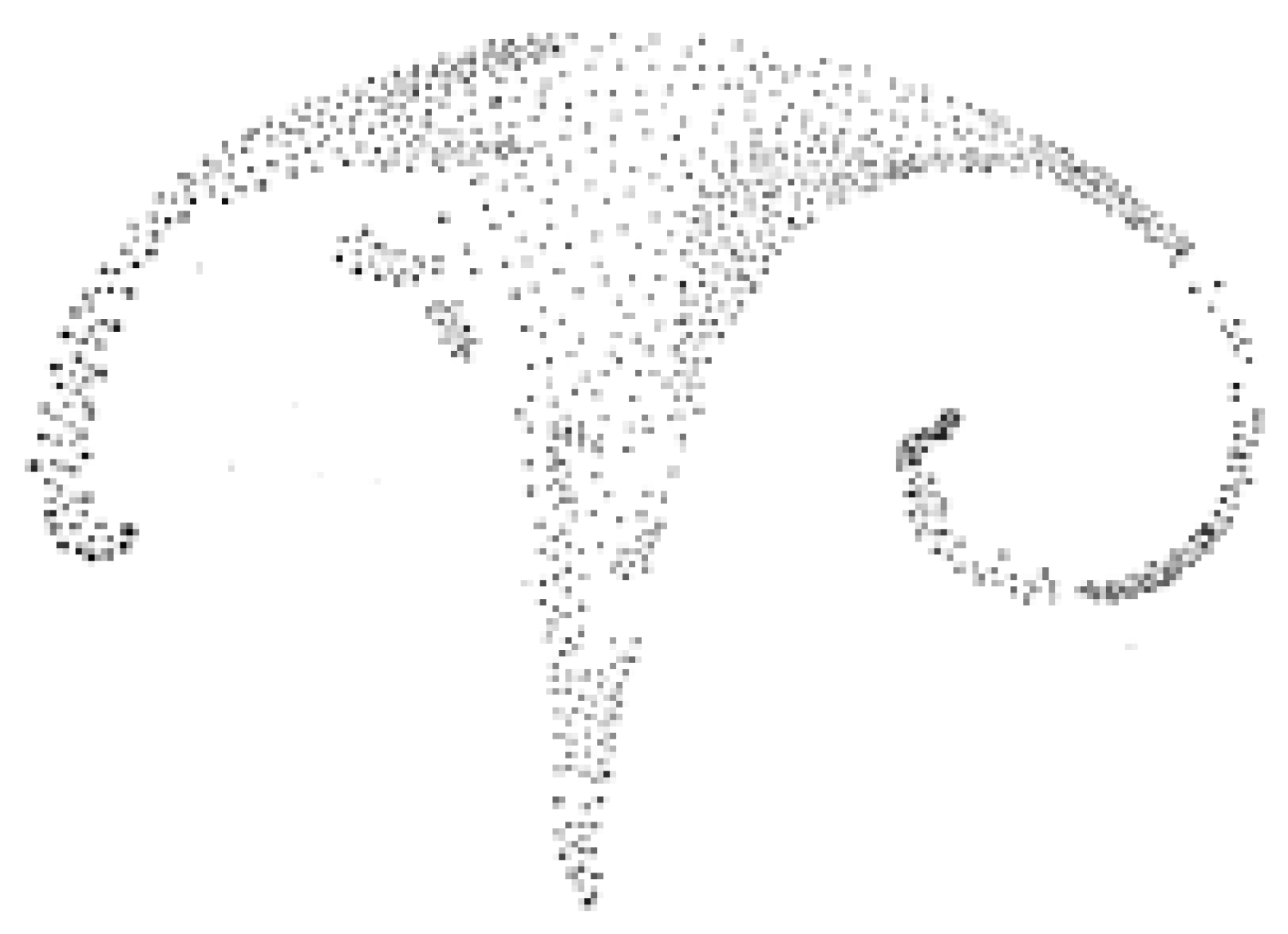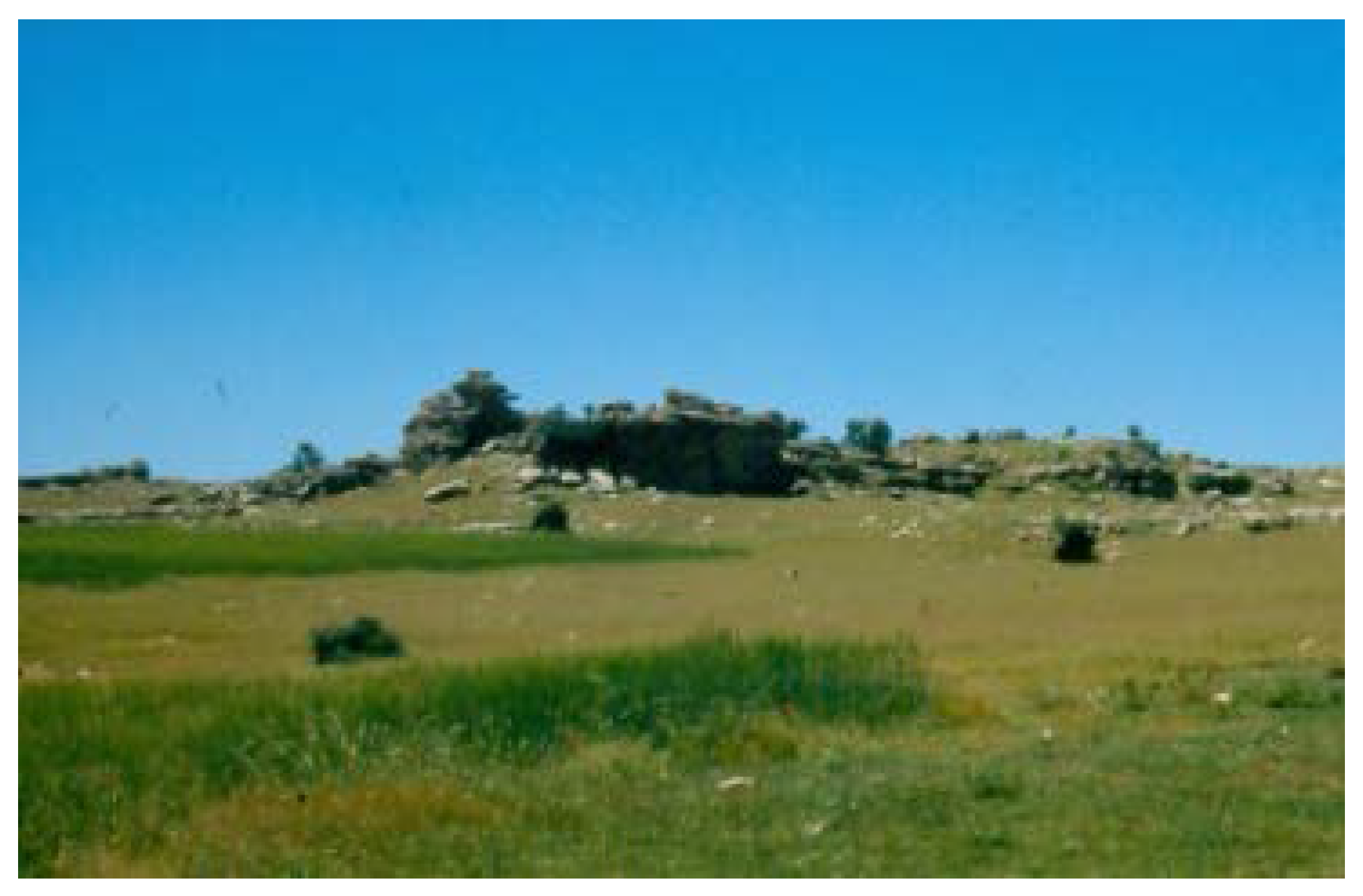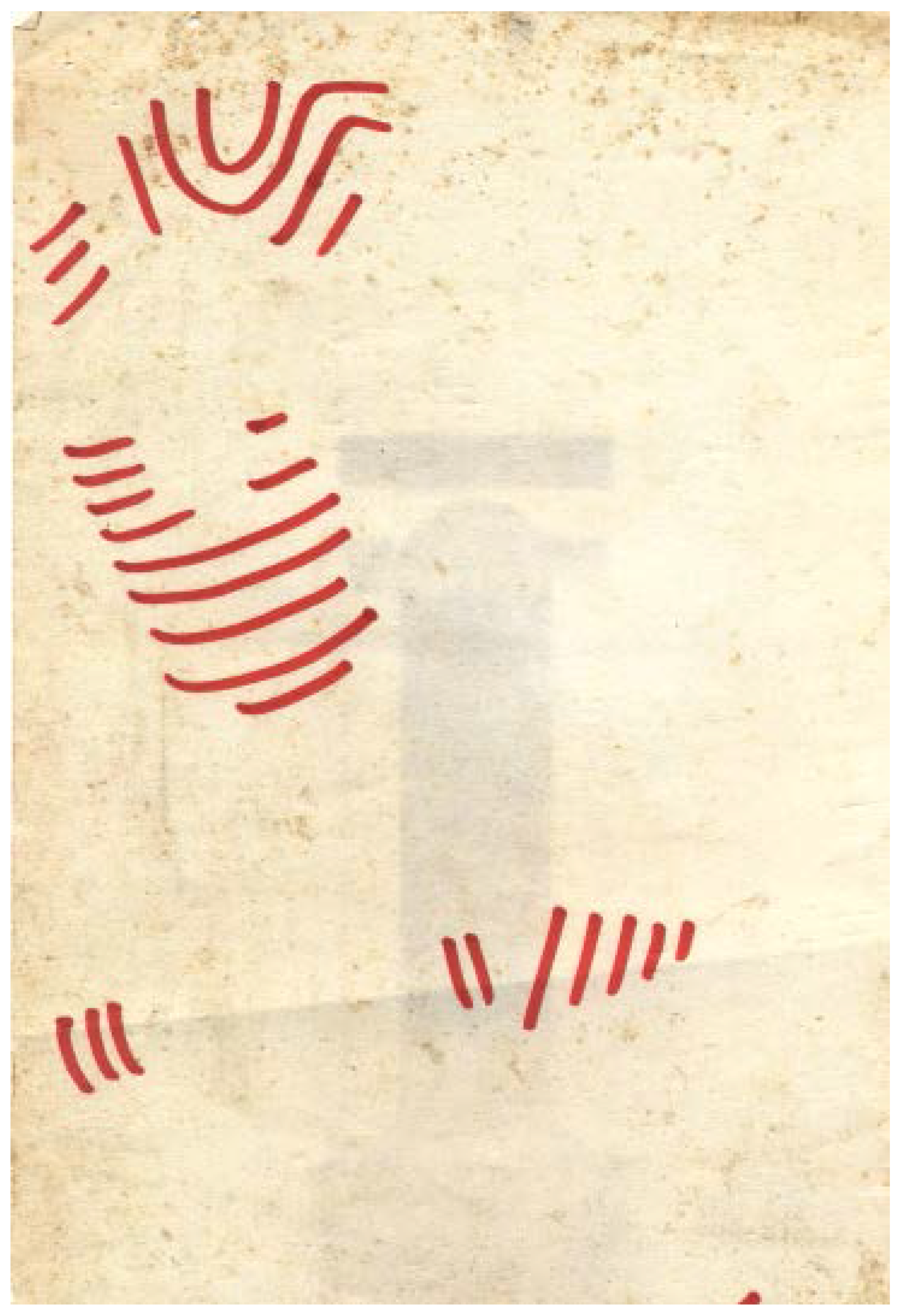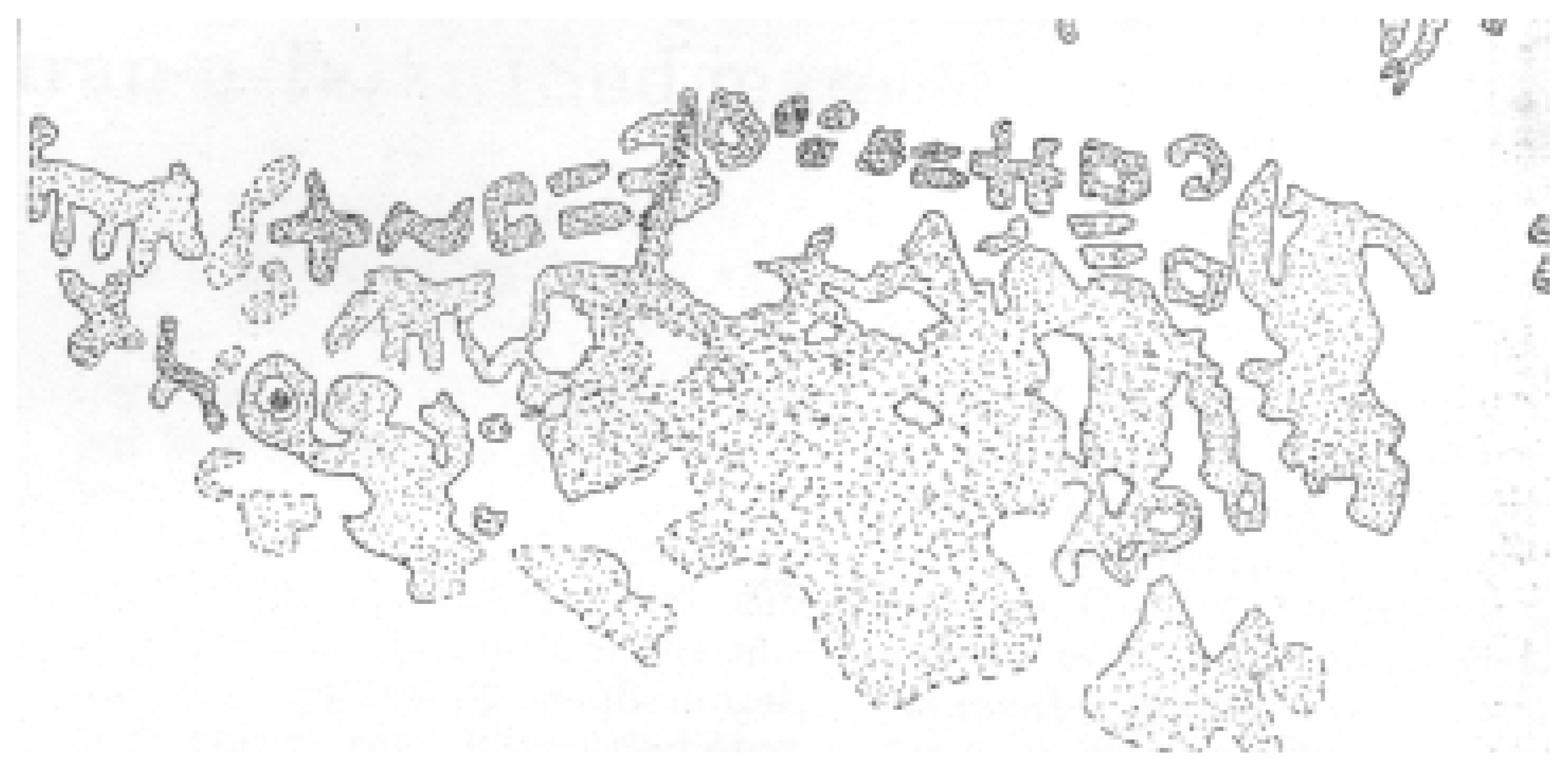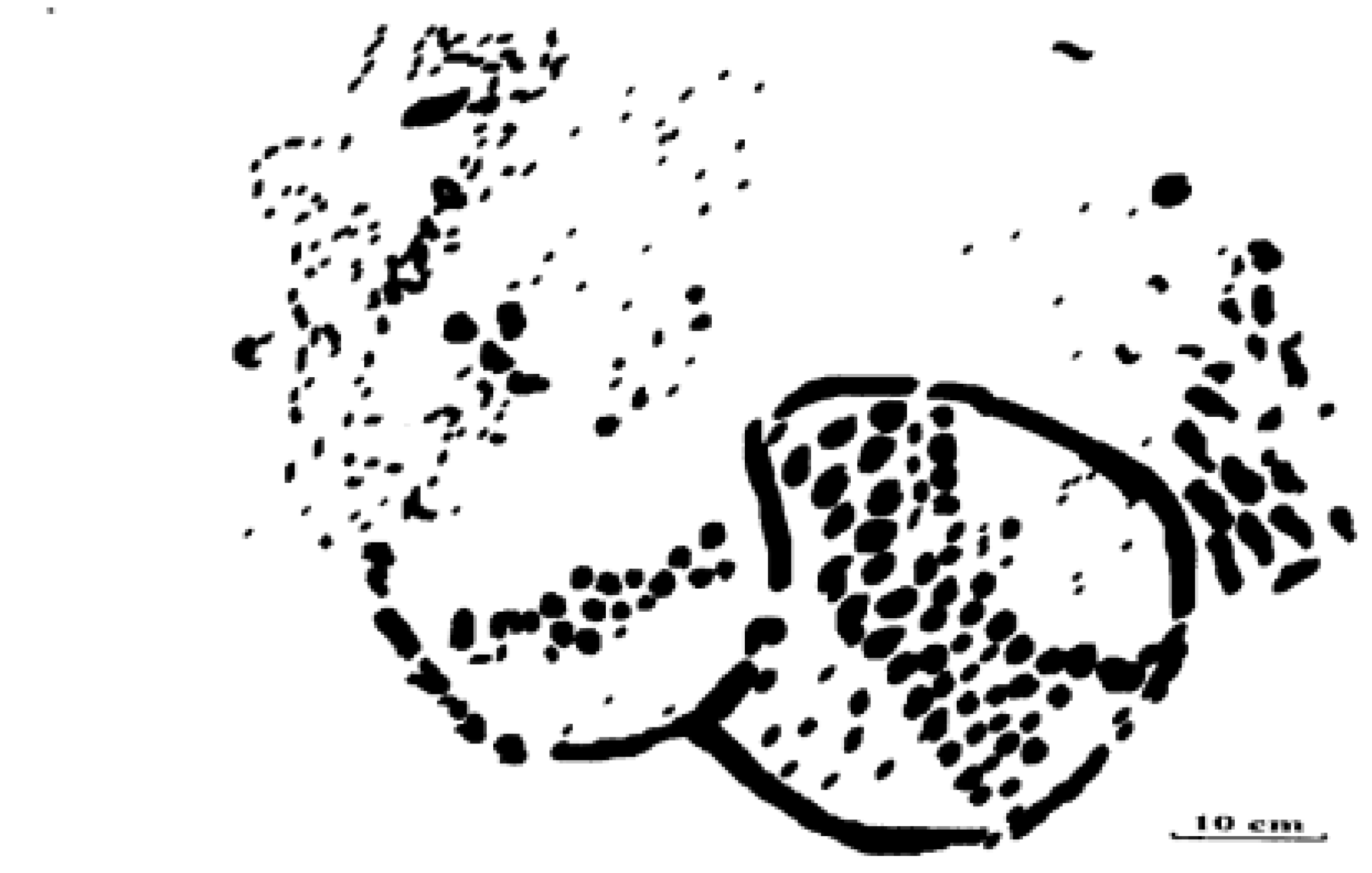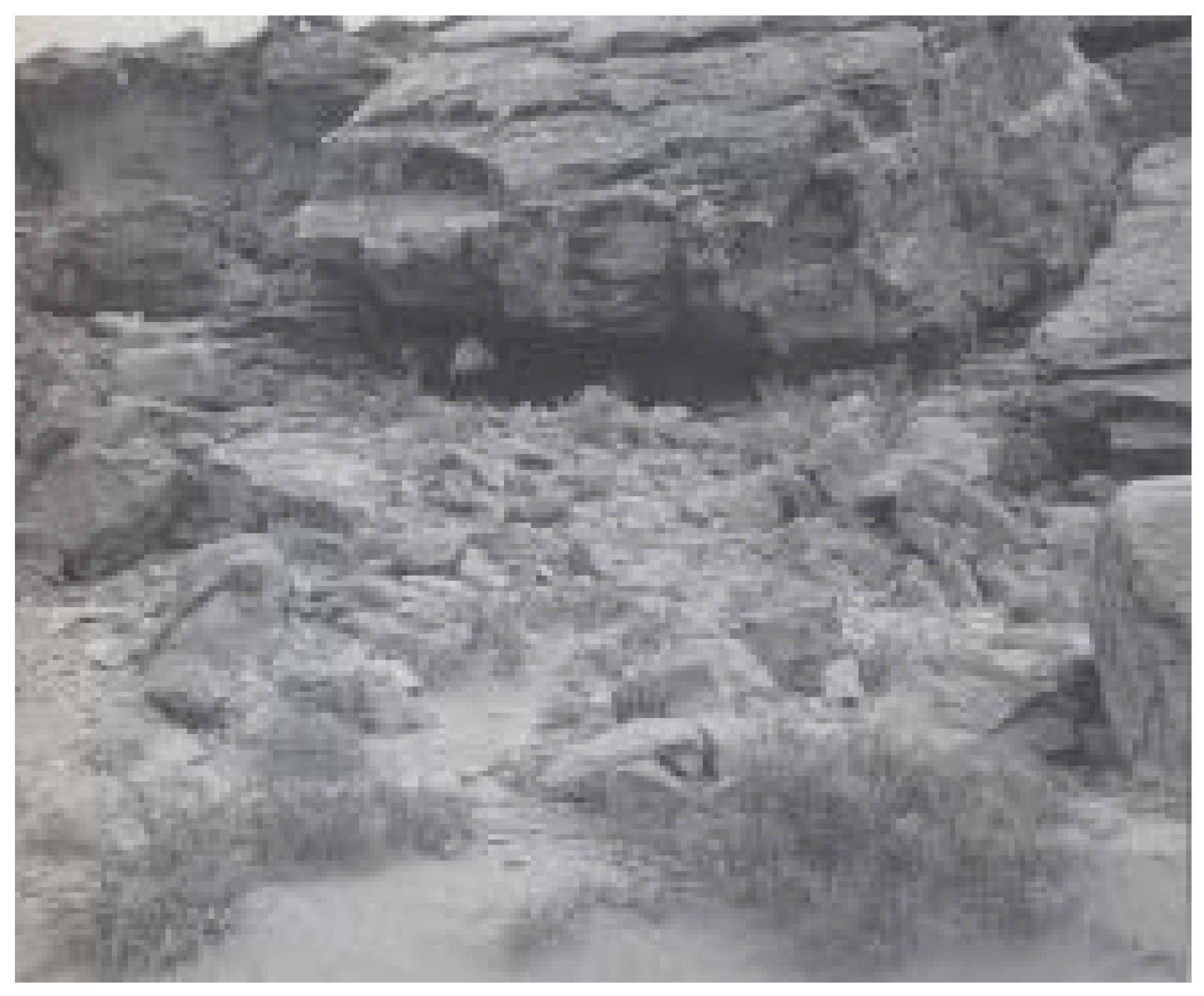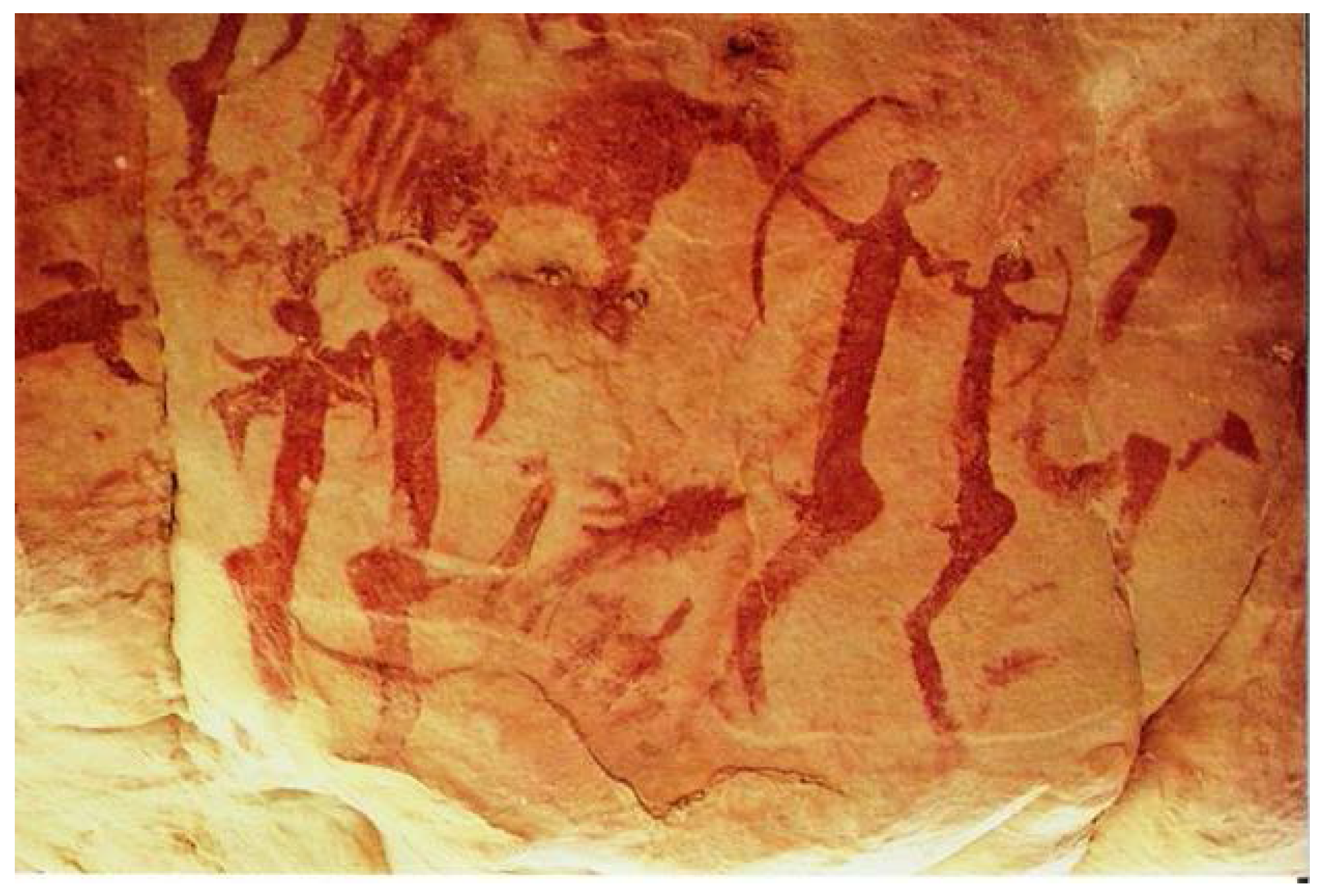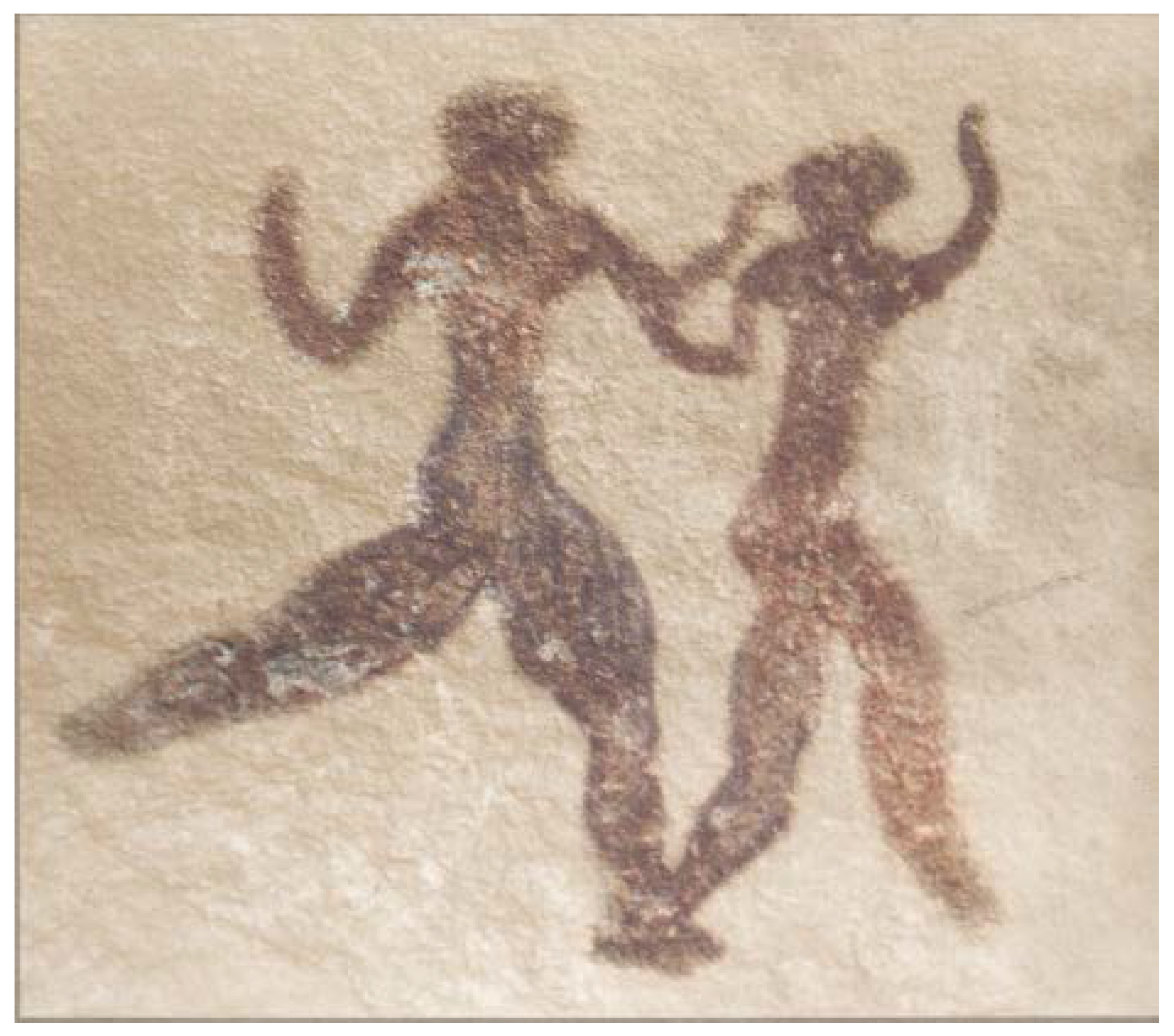1. Introduction
Morocco (
Figure 1) is well endowed with rock art sites: some 250 were recorded in the 1977 national inventory [
1]. Other sites found subsequently bring the total up to around 300. The vast majority are sites with petroglyphs; sites with paintings are rare. This is understandable, since for paintings to survive—and to be discovered today—they have to be in protected places, such as caves or rock-shelters. Paintings in the open air may well have existed but have long since disappeared. Research has also underlined the fact that the caves which house them are often used today as shelters for men and animals, with the inevitable deterioration of the paintings.
The sites are listed from north to south and from east to west.
2. Magara Sanar
This is the most northerly site with painted images in Morocco. The numerous paintings in red ochre on the roof of this small cave in the Jbel Tasbet, some 50 km east of the Atlantic town of Larache, were discovered in 1941 by a Spanish army officer [
2,
3]. The paintings are mainly made up of dots, arranged in parallel lines, rectangles, circles and meanders. Also depicted are schematic animals, including horses. A few human figures and animals can also be distinguished, with one man on horseback.
3. Kef El Baroud
Well to the south of Magara Sanar, this cave 10 km east of Ben Slimane and 30 km from the Atlantic coast and Rabat, was excavated from 1973 and. produced a wealth of Neolithic and Chalcolithic material [
4]. During excavation, it was also seen to contain nine pale red non-figurative paintings on the walls of both sides of the cave (
Figure 2). The most frequent motif was a pair of small spirals joined to short vertical line to form an image looking somewhat like the horns of a ram seen face on (
Figure 3). There is no way of knowing whether they are of the same as the archaeological material. Unfortunately, for some years now, the paintings have been invisible, covered by a thick black layer of smoke from fires lit by sheltering hunters and shepherds.
4. Tidrit
Further east, a number of red-coloured paintings were discovered in 1952 in a shelter in a rocky outcrop at a locality called Tidrit, some 5 km from Ifrane (Meknes) [
5] (
Figure 4). The paintings are mainly on the roof but some are also on the walls. They consist of curvilinear designs close together (concentric arcs and whorls) and short straight lines (
Figure 5).
5. Amzri, Toulkine
The Amzri rock shelter at Toulkine is the rock art site nearest to the petroglyph sites of the High Atlas. It lies much lower down, at 1800 m in the northern foothills of the High Atlas Mountains in the region of Amizmiz south of Marrakech. Numerous red-ochre paintings occur in seven shallow cavities on a ledge ca. 12 m above the Amzri rock-shelter (
Figure 6). They were discovered during the excavation of the shelter which produced an abundant Neolithic lithic industry and animal bones [
6,
7]. The paintings consist of lines of dots, parallel lines, curves, zigzags, combs, hand and finger tracings (
Figure 7) and two positive hands. Several black painted lines make up geometrical shapes. A palette containing red ochre, found in an archaeological level, was dated by TL to 2120-2420 BCE. As yet, it is the only date available for rock art manifestations in Morocco.
6. Imi Ouzerwane
Opposite the Amzri shelter, at Imi Ouzerwane, a series of shelters were noted to contain a few traces of red paint, doubtless the remains of complete paintings [
8]. The shelters are in such a bad state, however, that little can be said of these painted fragments.
7. Figuig-Icht
In Eastern Morocco, close to the Algerian frontier, at about 50 km north of Figuig, a large rockshelter, beside the road from Figuig to Iche, has several red-ochre paintings made up of abstract images and dots. The shelter has been much damaged [
9].
8. Oued Er Rkiza
Also in the region of Figuig-Iche, a concentration of paintings lies in one of the numerous cavities in the roof of a shelter on Oued Er Rkiza. It comprises abstract design—lines of dots, rectangles semi-circles—an anthropomorph and Libyco-Berber inscriptions. The colours are bright red and pale red [
9].
9. Imi n’Taroucht
In Southeastern Morocco, on the road from Tazzarine to Alnif—a region well-known for its numerous petroglyph sites—a single red-ochre bovid is painted on the wall of the Imi n’Taroucht: rock-shelter beside the road [
10].
10. Oued Rheris
In the vicinity of Erfoud, a rock-shelter in the middle valley of Oued Rheris contains 18 painted panels; mostly of Libyco-Berber inscriptions. There are also some 20 isolated possible alphabetical signs, 13 signs (mainly circles and squares) and 27 very schematic anthropomorphs, “often difficult to distinguish from crosses or trees” [
11].
11. Ifrane’n’Taska
A considerable number of paintings lie in five adjacent rock-shelters, at a locality called Ifrane’n’Taska, west of Zagora. All these shelters also contain stone structures showing their current use as animal pens. The colour of the paintings is variable: red, black, white and yellow. The images include fingerprints, lines, anthropomorphs, Libyco-Berber letters (
Figure 8), domestic cattle and wild animals. One shelter contains armed horsemen, various wild and domestic animals, hunting or battle scenes with anthropomorphs armed with spears and shields [
12,
13,
14].
12. Ain n’Thati
Near Ifrane n’Taska, at Ain n’Thati, four sections of this confused mass of boulders contain paintings. The first, a “corridor” formed by two large rocks touching each other, holds paintings of lines of dots on the roof near the entrance: further on, a red bovid is still visible with some traces of vague red ochre images under black soot on the ceiling; further on still, two shelters hold lines of just-visible dots [
15].
13. Zaouiat Sidi Abdenbi
Going further west, as far as Foum Zguid, two of the several rock-shelters at this site (also known as Zir Zabair), contain much damaged traces of paintings. Red ochre has been used to produce a series of dots, curvilinear and unidentifiable designs (
Figure 9). Black colouring matter was employed to paint three very schematic anthropomorphs [
8,
16].
14. Tamezrar
Further south, west of Tata, this site is a small shelter, on the edge of Oued Tamezrar, near Ait Ouabelli. It holds a few lines of painted red ochre dots [
15].
15. Touf Agdif
Also not far from Ait Ouabelli (Tata), situated about 15 km from the village of Tadakoust and 30 km northwest of Ait Ouabelli, on the bank of the Assif Aza Ifr, this large cave (ca. 100 m long and 7 m wide) contains about 60 paintings. The colours used are red ochre, a bright red colouring matter, black, white and green. The use of the DStretch enhancement technique enabled many vague images to be identified. They include armed horsemen (one with headdress, circular shield and two spears), horses, felines, unidentifiable quadrupeds, birds and geometrical forms. Two styles were identified, one elaborate and well executed, the other schematic [
17].
16. Assif Youmkat
This site, in the region of Fam El Hasn, lies about 2 km downstream on a tributary of the Assif Youmkat. It has some rocks with petroglyphs as well as a shelter with paintings. A mounted bovid and an armed human are visible. It was catalogued by Simoneau [
1] as 150.160, but all the relevant documentation was said to have been lost [
8].
17. Aounate Azguer
The first of this series of 21 rock-shelters about 130 km southeast of Tan-Tan, not far from the mouth of the Oued Draa, was published in 2001/2002 under the name of Laounate [
18] (
Figure 10). The shelter contains about 100 red ochre motifs painted on the walls and ceilings, depicting sexed archers accompanied by ostriches, lines of very small anthropomorphs, giraffes, various quadrupeds and two chariots (
Figure 11). At the time of their discovery, the style and themes of the paintings were totally unknown in Morocco. The area is under study and new shelters constantly discovered.
18. Oued Amhite
The small site of Oued Amhite, near the mouth of the Oued Draa, is situated upstream of Oued Amhite. It contains an unusual red-painted hunting scene, showing two hunters and an antelope on its back. It also depicts two possible fish and an unidentifiable image [
19].
19. The Saguiet el Hamra and the Rio de Oro
The rock art of the Saguiet el Hamra and the Rio de Oro has always been the subject of confusion. In the early days many Spanish researchers published reports on the area, but not all knew exactly where they were. Many judged “their” site to be totally new, whereas in fact part at least had already been published. The recent division of these provinces into two parts has also produced some confusion: research teams, mainly from Spanish universities, working in the mountainous Zemmour and the desert Tiris, have renamed and relocated a number of sites, many of them listed in the Moroccan inventory of sites [
1] (reference numbers, where available, are given in brackets after the site name), see particularly the numerous articles of Saez de Buruga, and Soler Subils).
20. Pozo El Farsia
The Pozo El Farsia (Mahbes) site ([
1], 150.239), well east of Smara, is made up of two shallow rock-shelters in a low cliff opposite the well-known well of El Farsia. It holds a number of possible Libyco-Berber (tifinar) signs, some as petroglyphs, others painted (but they look more like camel markings) [
20,
21].
21. Uad Ymal
This site is a rock-shelter southeast of Smara with a number of painted motifs, including anthropomorphs, both stylized and realistic [
22].
22. Dmeri Labya
Again in the Smara region, this is a small site holding a number of red-coloured paintings [
19].
23. Tifariti
Several rock-shelters in the direction of the locality of Mahbes, east of Smara and about 200 km southwest of Ras Lemtareg (150.241), contain red ochre paintings with many positive handprints, wild and domestic animals and anthropomorphs [
23].
24. Rekeiz Lemgasem
This area, in the Zemmour hills, in the north-east of the Atlantic Sahara, about 30 km from Tifariti, has been the object of research by teams from Girona University since 1995 [
24]. Sites recorded were Sluguilla Lawask, Rekeiz Lemgasem, Rekeiz Ajahfun, Wadi Kenta, Wadi Ymal (see above), Asako and Bou Dheir. Most images were small (between 10 and 20 cm). 60% of them were figurative (32% humans, 28% animals), 24% were hand-prints, 16% were non-figurative, the rest were unidentifiable (
Figure 12).
25. Bou Dher
A series of rock-shelters in a sandstone cliff in the Zemmour hills include a large fresco depicting a variety of wild animals. Many human figures are also clearly visible, the shelter having suffered little damage [
25].
26. Leyuad
About 40 km ESE of Auserd in the Rio de Oro, close to the Mauritanian frontier, a series of rock-shelters were divided by the researchers [
26] into five separate units, each holding one or more rock-shelters. Station I: the Cueva del Diabolo contains petroglyphs and some abstract red-coloured paintings, as well as recent inscriptions in Arabic. Station III: the large Cueva Pintada cave, holds red-ochre schematic paintings of wild animals, geometrical signs and, in black, a few Libyco-Berber inscriptions. Station IV; a small, unnamed, much damaged, shelter has one wild animal painting in red-ochre. Station V: 3 shelters (A, B, C) contain, respectively, red and white paintings of giraffes and gazelles on the roof; red painted anthropomorphs and zoomorphs; the rock surface of the upper shelter was in such a bad shape that nothing could be seen. Station VI: the badly preserved red paintings include anthropomorphs and Libyco-Berber letters.
27. Eiy Mountai
Ten km south of Leyuad, this site is made up of three stations. The first is a cave decorated with several red coloured designs similar to those in the Cueva Pintada (see above) plus a horseman. The second is a niche situated above the first one, its walls holding very schematic anthropomorphs and horsemen in red and yellow. The third, known as Hassi Eiy is only noted for a fragment of red paint found on a slope to the south of the well [
8].
28. Daraa El Quelba
At this site, lying on the southern slope of a rocky peak, 10 km west of Leyud, the red paintings are said to be invisible because of the many Arabic inscriptions overlying them [
8].
29. Abrigo del Capitan Justo
Very close to the Mauritanian frontier, SE of Leyuad, this rock-shelter, discovered by a Spanish army officer, contains stylized red-ochre paintings of anthropomorphs and Libyco-Berber inscriptions. Black painted camel-markings and inscriptions in Arabic are also visible [
26].
30. Legteitira
This cave is said [
8] to hold small red-coloured paintings of: the hind part of a bovid and an anthropomorph.
31. Comments
The themes of the painted images correspond only partially to what has been recorded for petroglyph sites. Wild animals and humans are a frequent subject, but domestic cattle, so numerous on petroglyph sites, are rarer. Libyco-Berber inscriptions are also less often painted. Weapons—apart from bows and spears—are absent. On the other hand, rows of small dots occur on many painted sites, both in the north and in the south. It has been suggested ([
8], Heckendorf & Salih, 1999, p. 251) that they were possibly part of a sign-communication system.
As with petrohlyphs, many images are abstract designs or unidentifiable. Wavy and curved red painted lines are also a feature on several sites. A few rare paintings are in white or green but the most usual colouring matter is red ochre. Charcoal was also employed, often for inscriptions.
32. Conclusions
It has been seen that sites with painted images range from north Morocco to the far south. But painted sites are unlikely ever to be as numerous as sites with petroglyphs, given the modern use of caves as living places for animals and humans. However, a big advance has been made with the increasing use of techniques such as DStretch enhancement, which adds a new dimension to the value of these images (see, for instance, Touf Agdif, N°15 above). A new look at already known sites would be productive.
The daring of painted sites by the analysis of the colouring matter used is certainly possible. But most of these sites are very individual in their contents and direct dating is unlikely to produce useful patterns applicable on a larger scale—Amzri (N°5) is a case in point. It is to be hoped that when more of these sites are discovered, some territorial or thematic will in fact emerge.
